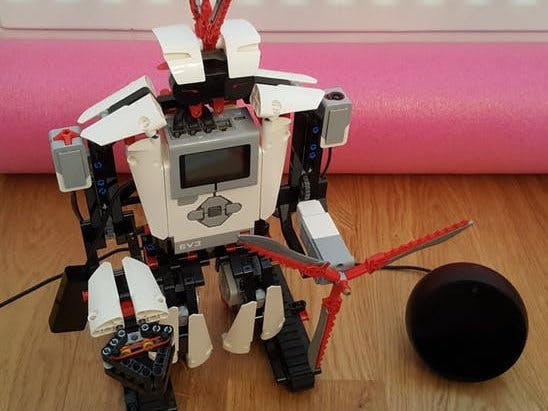This tutorial can act as a continuation of an excellent LEGO MINDSTORMS Voice Challenge at Hackster.io. So, ideally you should complete all 4 missions from that challenge first and then jump to Step 1 of this tutorial to carry on.
If not, don't worry. Start with Step 0 below to setup the environment and then follow all other steps below in sequence.
Pre-requisites:For this tutorial, you would need the following hardware components:
- Lego Mindstorms EV3 Robotics Kit. See the Amazon link;
- Amazon Echo device compatible with Alexa Gadget Toolkit. See the Documentation link;
- Computer with the Internet connectivity and Visual Studio Code IDE. You can download Visual Studio Code from here
- Build your EV3 robot, following the instructions from the Lego manual.
- Next, install ev3dev (Debian Linux based operating system), so that you can launch Python 3.x based applications on your EV3 Brick. Detailed installation instructions can be found here
Note: You need to complete steps 1 to 6 in eve3dev installation above. As a reward, in Step 6 EV3 robot will be able to read your fortune :-)
- Then install ev3dev-browser extension as described in Set up Visual Studio Code.
- Finally, set up the Alexa Gadgets Toolkit (AGT) Python Software, so that your EV3 robot can interact via AGT interface with your new Alexa skill that you will deploy shortly.
- Sign in with your Amazon developer account at developer.amazon.com. If you don't have an account yet, you can create new one.
- Then from the top menu select Alexa -> Alexa Skills Kit.
- Press Create Skill button and provide a name and default language for your new Alexa skill.
- In "Choose a model to add to your skill” section select Custom.
- In "Choose a method to host your skill's backend resources" section select Alexa-Hosted (Node.js).
- Then press Create skill button in the upper right corner. It will take about one minute to create your skill and open it in Alexa Developer Console.
- From the left navigation bar select Interfaces, then on the right side activate Custom Interface Controller. It will allow Echo device to send commands / directives to EV3 Brick and receive events from it back.
- Now from the left navigation bar select JSON Editor, then replace schema definition on the right with content from Git-attached alexaskill-nodejs/model.json file.
- Then Save Model and Build Model using buttons in the upper part of the screen.
- From the top navigation bar select Code, then copy content of Git-attached alexaskill-nodejs/lambda/index.js, alexaskill-nodejs/lambda/package.json and alexaskill-nodejs/lambda/util.js into relevant files under shown Skill Code/lambda directory.
- Click create file icon, enter the name as lambda/common.js and copy there content from Git-attached alexaskill-nodejs/lambda/common.js.
- Save all the changes, and the Deploy your Alexa skill, using relevant buttons in the upper part of the screen.
- Upon successful deployment, from the top navigation bar select Test, then enable testing in Development.
- Open your skill using Skill Invocation Name, e.g. "open robot dice roller". As you are using simulator, you should get a response, stating "I couldn't find an EV3 Brick connected to this Echo device. Please check to make sure your EV3 Brick is connected, and try again.". It proves that the new Alexa skill is functional, but cannot connect to EV3 Brick yet - something that we'll look at in the next step of this tutorial.
Note: Invocation name can be set or changed in Alexa skill's Build section of Developer Console.Step 2 - Alexa Gadget registration
Your EV3 Brick needs to be registered as an Alexa Gadget to enable its integration and data exchange with compatible Echo device.
- If you are still in Alexa Developer Console, click vertical ellipsis, select Alexa Voice Service option and then press Products button.
- Click Create Product button in the top right corner of the screen and fill in all the required fields. Ensure, that the product type is set to Alexa Gadget, and the product category to Animatronic or Figure.
- Open newly created Product record and copy details of the system-generated Amazon ID and Alexa Gadget Secret.
- Copy those details into agt-python/mission-dice.ini, downloaded from this Git repo.
Note: EV3 robot will use these credentials to authenticate itself and establish Bluetooth connectivity with the Echo device in Step 3 below.Step 3 - Test EV3RSTORM with the Alexa skill
After completion of all the steps above we should have now Alexa skill hosted in the cloud and relevant credentials obtained for EV3 Brick function as an Alexa Gadget. Now, it's the moment of truth - to that EV3 and Echo can work in tandem.
- First of all, you need to activate Bluetooth on EV3 Brick. Navigate to its Wireless and Networks menu, select Bluetooth and set it on.
- Second, open extract of this Git repo in Visual Studio Code. On EV3 side, only content of agt-python will be utilised: mission-dice.ini (which you updated in Step 2 above) and mission-dice.py (the actual EV3's logic, written in Python). From the lower part of the screen extend EV3DEV Device Browser, connect to your EV3 Brick and click Send workspace to device icon. It should upload our program to EV3 Robot's flash storage.
- In EV3DEV Device Browser, right click your EV3 Brick and select Open SSH Terminal. You can execute now any commands directly on EV3.
- In SSH terminal switch to the directory holding your mission-dice.ini and mission-dice.py, e.g.
cd agt-pythonthen launch the program itself
sudo python3 mission-dice.pyIf asked for a password, use maker (default password, unless you've changed it to something else). In a few minutes, EV3 should confirm that it has connected to Echo device.
Congratulations !! You have completed all the technical steps and should have now a paired EV3 + Echo solution. Go ahead and use it to roll some virtual dice in your favourite board game(s) !!
High level overview of the solution designWe combine EV3 Brick and Amazon Echo's strengths in this solution. Echo device equipped with the new Alexa skill will provide speech recognition and speech synthesis capabilities, while EV3 Brick will use its colour sensor to identify the colour of the shown token or card, and its touch sensor to detect the haptic input from the player.
If you'll check index.js of the hosted Alexa skill, you will see that upon activation of the skill through its invocation name, e.g.
"Alexa, open robot dice roller"it will use LaunchRequestHandler to verify token provided by EV3 Brick. If successful, Echo device will verbally confirm interface activation. It will also keep handling events from EV3 Brick for 10 minutes as per below, overwriting system's shorter default timeout settings.
let speechOutput = "Ho-ho-ho, Chappie's voice interface activated";
return handlerInput.responseBuilder
.speak(speechOutput + BG_MUSIC)
.addDirective(Util.buildStartEventHandler(token,60000, {}))
.getResponse();Next, we'll use Alexa voice command to activate game mode.
"Alexa, activate game mode"Echo device will use its SetCommandIntentHandler to send a directive to EV3 Brick with the command name, and confirm verbally activation of the new command.
let directive = Util.build(endpointId, NAMESPACE, NAME_CONTROL,
{
type: 'command',
command: command,
speed: speed
});
let speechOutput = `command ${command} activated`;
return handlerInput.responseBuilder
.speak(speechOutput + BG_MUSIC)
.addDirective(directive)
.getResponse();On EV3 side we should have mission-dice.py application already running. Its on_custom_mindstorms_gadget_control function will extract command name from the payload of received directive, set quiz mode on and fire Speech event back to Echo, requesting player's token.
if command in Command.QUIZ.value:
self.quiz_mode = True
self._send_event(EventName.SPEECH, {'speechOut': "Show me your coloured token"})Players in turn would need to show then their tokens / cards to EV3 Brick by holding them 5-10mm above its colour sensor (left shoulder, if you assembled the robot as per the original Lego instruction) and then press its touch sensor (right shoulder, if you assembled the robot as per the original Lego instruction).
We have EV3's colour sensor set in Lego-bricks-colour detection mode, as per the configuration in line 69.
self.cl.mode = 'COL-COLOR'So, while quiz mode is on, it will be checking whether touch sensor is pressed. If yes, it colour code from the colour sensor will be read and sent as a part of Touch event back to Echo device.
while self.quiz_mode:
if self.ts.is_pressed:
print("Touch sensor pressed. Sending event to skill")
self.leds.set_color("LEFT", "RED", 1)
self.leds.set_color("RIGHT", "RED", 1)
self._send_event(EventName.TOUCH, {'answer': self.cl.value()})
# self.quiz_mode = False
time.sleep(0.2)
time.sleep(1)In Alexa skill's index.js file in line 30 we provided Echo with the array of colours that EV3's colour sensor can return.
const COLOR_NAMES = ["No color", "Black", "Blue", "Green", "Yellow", "Red", "White", "Brown"];So, when Echo device receives an event and its EventsReceivedRequestHandler verifies that it's a Touch specific one, it will read the colour code first. If it's bigger than 0, i.e. colour sensor was able to determine certain colour, then Alexa skill will generate a random number between 2 and 12 to simulate dice roller and instruct relevant player on the number of steps to take.
if (name === 'Touch') {
let answer = parseInt(payload.answer);
if (answer > 0) {
var dice = Math.floor(Math.random() * (+DICE_MAX - +DICE_MIN)) + +DICE_MIN;
let playerColor = COLOR_NAMES[answer];
let speechOutput = ("Player " + playerColor + ", please make " + dice + " steps ahead");
return handlerInput.responseBuilder
.speak(speechOutput, "REPLACE_ALL")
.withShouldEndSession(false)
.getResponse();
}
}That's all ! Now try it for yourselves. And as they used to say in "Hunger Games", may the odds be ever in your favor!!
Working model - YouTube videoYou can find short demo of the working solution here on YouTube.
















Comments
Please log in or sign up to comment.